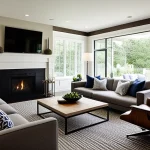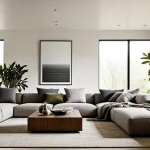Achieving Balance Between Modern and Traditional Elements in UK Homes
Striking a harmonious interior requires understanding the core characteristics of both modern and traditional UK home design. Traditional design often features intricate woodwork, classic mouldings, and warm, rich tones, embodying history and elegance. In contrast, modern elements introduce clean lines, minimalism, and neutral colours that emphasize functionality and open spaces.
To blend modern and traditional styles successfully, start by identifying key features you want to highlight from each style. For example, retain original fireplaces or mouldings while incorporating sleek, minimalist furniture. This approach allows for visual interest without overwhelming the space.
Additional reading : Is the UK Media Upholding Its Responsibility to the Public?
Strategies for finding a middle ground include choosing a neutral colour scheme to unify diverse elements. Combining classic materials like wood with contemporary finishes can enhance cohesion. Additionally, balance scale and proportion so neither style dominates; a large antique armchair can coexist with a slim-lined modern sofa if thoughtfully placed.
Ensuring cohesive visual balance means paying attention to texture, colour, and arrangement. The goal is a seamless blend that feels intentional and inviting—a hallmark of successful UK home design that honors both heritage and modern living standards.
This might interest you : How can technology enhance efficiency in UK real estate finance?
Practical Tips for Mixing Materials, Colours, and Textures
Blending modern and traditional elements in UK home design demands careful combining of materials to achieve harmonious interiors. Classic materials like wood and stone create warmth and character, while modern finishes such as metal or glass add sleekness and lightness. To avoid visual clash, pair richly grained woods with matte or polished metals, striking a balance between tactile richness and contemporary elegance.
When selecting colour schemes, opt for complementary palettes common in UK homes. Neutral bases—shades of cream, taupe, or soft grey—offer flexibility, uniting old and new features. Accents in deep blues, muted greens, or warm terracotta can echo traditional hues while remaining fresh and modern. This approach ensures cohesion without sacrificing vibrancy.
Texture layering is crucial for weaving together diverse design influences. Mixing rough stone or exposed brick with smooth modern surfaces creates depth and tactile interest. Incorporate fabrics like linen, velvet, or woven wool to build warmth. Thoughtful texture combinations make spaces inviting and visually balanced, enriching the overall interior design. By integrating these practical tips, homeowners can confidently craft interiors that celebrate both eras with style and cohesion.




